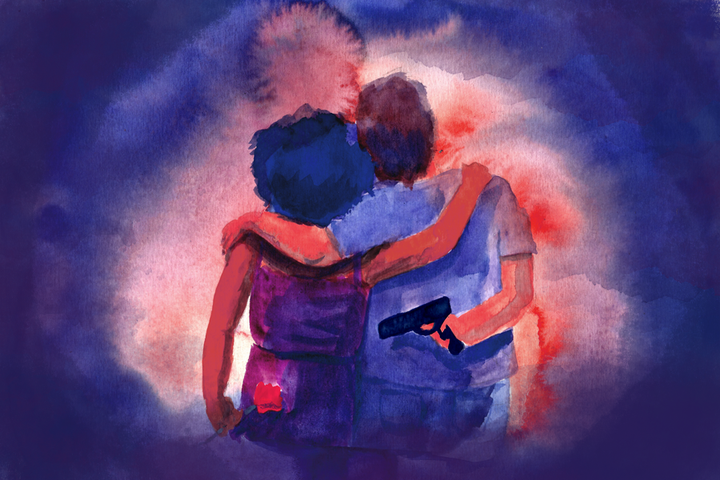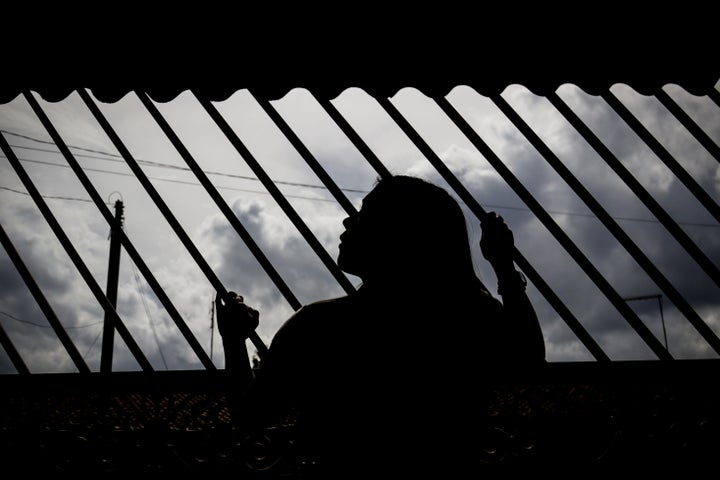
SÃO PAULO — “Don’t you worry, I’m taking a life today.” The voice in the video on Fernanda’s cellphone belongs to her ex-husband. Gun in hand, he’s threatening her once again. She holds their 7-month-old daughter, whose life — along with her own — Fernanda is trying to protect.
She can’t get rid of the memories of the abuse. Fernanda, 23, is on medication for anxiety and depression. “He used to hit me in the head,” she told HuffPost Brazil. “He used to say, ‘I’m going to hit you in a way that won’t bruise.’ He cut my face with a knife. He said he was going to kill me. He repeated this threat over and over.”
Fernanda, who, along with the other survivors in this article, is being identified by a pseudonym due to safety concerns, is still trying not to become another victim of femicide in Brazil.
Thirteen women are murdered every day in Brazil, according to a 2019 survey from Ipea, a Brazilian government agency that compiles official violence data. The numbers are from 2017, the latest available, and represent a 30% increase over the average from 2007.
The staggering levels of violence against women in Brazil prompted action by former Brazilian President Dilma Rousseff. She signed the Femicide Act into law in March 2015. The law made the murder of women or girls because of their gender a hate crime, and increased prison terms to for femicide from 12 to 30 years, compared to just six to 20 years for common homicide.
The Femicide Act, however, is failing in many ways.
Human rights campaigners say 40% of all murders of women across Latin America and the Caribbean occur in Brazil. In the state of Rio de Janeiro alone, the Inter-American Commission on Human Rights says media reports show an average of 300 women are murdered each year; in the state of São Paulo, 377 women were murdered from January to November in 2018.
The IACHR, part of the 35-member Organization of American States, says that in most cases the victims had reported previous acts of domestic violence by the killer, including attempts on their lives, and that the attackers were or had been partners of the victims.
“It is a crime that has its own characteristics,” said Valeria Scarance, who leads the gender crime task force for the prosecutors of São Paulo state. “The categorization [of the crime as femicide] from early on is important because that means that the investigation will be much more focused.”
A lack of official government statistics has created confusion over when to classify crimes as femicide, meaning verdicts and sentences aren’t always in proportion to the severity of the crime, Scarance said.
“Femicide is not an act of love. It’s an act of annihilation.”
- Valeria Scarance, prosecutor who leads a gender crime task force in Brazil
“Jurors have little awareness about femicide,” she said. “There is this false notion that men commit these crimes motivated by despair, as an act of love. Femicide is not an act of love. It’s an act of annihilation.”
Scarance pointed to a survey conducted in the city of São Paulo, in which most respondents categorized a crime as femicide when the accused was a partner or former partner of the victim. However, they were less sure when there wasn’t a romantic element to the relationship. Cases in which the victim was the mother, sister or neighbor of a perpetrator were typically not considered to be femicide.
The administration of President Jair Bolsonaro ― who himself is known for using macho, gendered political rhetoric ― is not transparent in its actions to address violence against women, which has made it even harder to assess the federal government’s current efficiency in dealing with the issue.
Fernanda’s ex-husband is now in custody awaiting a court hearing after he violated a restraining order. Fernanda fears he may look for her again, as he did when she was hiding at a friend’s house earlier this year, if he is not convicted and sent to prison.
“He found out her address, jumped over the fence and grabbed me by my hair, trying to force me to come home,” she said. “On Jan. 1, he forcefully took my baby. I called the police.”
When Home Isn’t Safe — But Neither Is Leaving
One common thread to femicide is that many women are assaulted at their own homes. To save their lives and those of their children, they must flee, leaving everything behind. In 2007, 1,019 out of 3,778 women murdered in Brazil were killed in their own homes. In 2017, that number had increased by 38% to 1,407 women killed at home out of a total of 4,936 murders.
“Home is where the woman is ‘unarmed,’ in the sense that that is where she’s the most vulnerable,” said Fabiana de Andrade, an anthropologist from the University of São Paulo. “On top of that, they may not realize immediately that they are being assaulted, that this kind of behavior is not normal. When this realization comes too late, the violence can become lethal.”
Luísa, 33, left a violent five-year relationship last June.
“I have scars all over my body: cuts from scissors, knives, serrated knives, bites,” she said. “I was clubbed on the head, on my back, on my arms.”
She walked for about 3 miles until she could find someone to give her money to take a bus to her mother’s house. When her ex-partner went looking for her, she reported the abuse to the police.
Luísa obtained a restraining order against her ex, but they got back together a few months later.
“I went back to him. And I did not go to court. I did not follow up,” she said. “Then it all started again. I went back to the police station and got another restraining order against him.”
She says she decided to put an end to the cycle of abuse for the sake of her 1-year-old son and her mother. “On that day [that I decided to leave], he told me he only wouldn’t kill me right then and there because our son was in the room,” she said. “From that point on, I said to myself: ‘I can’t trust this man any longer.’”

In the majority of cases, however, even the aggressor moving away from home isn’t enough to keep women safe.
Veronica, 45, was stuck in a cycle of physical and psychological violence with her ex-husband. In April 2018, after being separated from him for four years, her former partner broke into her house. “Somehow he removed the iron bars from the front gate,” she said. “He punched my boyfriend’s car. Broke windows. He did it all. I thought he was going to come inside to kill me. It was pure rage.”
Veronica and her neighbors called the cops, who came before the man could make his way into the house. “Had [my ex] entered the house, he would have killed me,” she said.
Lives Forever Changed
Since justice can move extremely slowly in Brazil and many women have no safe place to go to, some states offer shelter for up to three months.
The “house shelters” are secret — women can’t even bring their cellphones with them, for fear the devices may be tracked. Victims of abuse are directed to the shelters by the police, after a risk assessment. They are free to leave whenever they choose.
Luísa and her son arrived at one of the house shelters in Brasília, Brazil’s capital, in December. Her routine involved taking care of him and doing chores. Helping in the kitchen and cleaning the rooms were a way of keeping herself busy. On Thursdays and Fridays, she could call her mother. She only left the shelter to see a social worker.
The lack of activities is a common complaint. “I wish there were more opportunities in here,” Luísa said. “There are many idle [sewing] machines here. We could be doing something, keeping our minds occupied. Sometimes the head is so empty that [the thought] pops up: ‘Is it worth staying alive?’”
The state department for women’s issues claims that education or training programs are not viable because of the high turnover in the facilities. It says the physical isolation is justified because of the dangers faced by the women.
Children As Witnesses And Victims
When she was 6, Veronica’s daughter witnessed the destruction caused by her father. Luísa’s son was present when his father beat his mom. These cases are by no means exceptions to the rule.
“In most cases these battered women have kids, and they are home. They live there. They see things. And, in many cases, the children are victims of an indirect violence, even if it is not directly witnessed,” said Silvia Chakian, a prosecutor from São Paulo state.
Veronica said her daughter can be startled by loud noises. “She must have made some sort of association. She cried a whole week,” she said.
One big worry is that kids grow up thinking this is a normal relationship.
“Some studies show that these children can suffer from disorders, struggle with relationships; girls may look for abusive relationships and boys may try to reproduce this violent behavior in their future relationships,” Chakian said.
Ultimately, experts suggest education and consciousness-raising may help women and their families.
Veronica said she didn’t initially understand the severity of her situation, and that she minimized aggressions because her partner “did not hit violently.”
“Today, I consider myself a survivor,” she said. “Every day.”
Need help? In the U.S., call 1-800-799-SAFE (7233) for the National Domestic Violence Hotline.